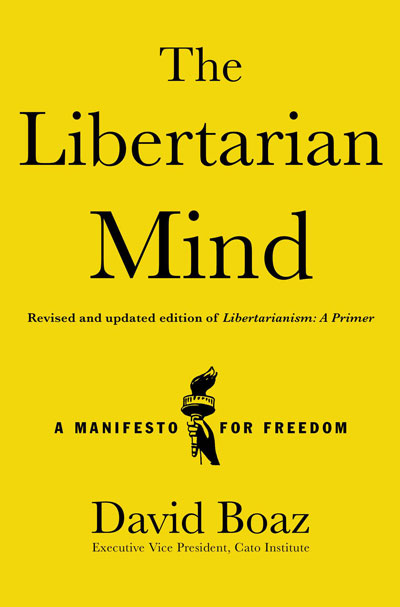The Authoritarian Giuliani
Surprising as it is to me, I’ve run into a number of libertarians and libertarian-leaning Republicans recently who think the tax-cutting, pro-choice Rudy Giuliani would make a good president. To those people I recommend my recent op-ed in the New York Daily News:
Throughout his career, Giuliani has displayed an authoritarian streak that would be all the more problematic in a man who would assume executive powers vastly expanded by President Bush.
As a U.S. attorney in the 1980s, Giuliani conducted what University of Chicago Law Prof. Daniel Fischel called a “reign of terror” against Wall Street. He pioneered the use of the midday, televised “perp walk” for white-collar defendants who posed no threat to the community….
As a presidential hopeful, Giuliani’s authoritarian streak is as strong as ever. He defends the Bush administration’s domestic surveillance program. He endorses the President’s power to arrest American citizens, declare them enemy combatants and hold them without access to a lawyer or a judge. He thinks the President has “the inherent authority to support the troops” even if Congress were to cut off war funding, a claim of presidential authority so sweeping that even Bush and his supporters have not tried to make it.
Giuliani’s view of power would be dangerous at any time, but especially after two terms of relentless Bush efforts to weaken the constitutional checks and balances that safeguard our liberty.
In 1964, Barry Goldwater declared it “the cause of Republicanism to resist concentrations of power.” George W. Bush has forgotten that; Rudy Giuliani rejects it.
Posted on June 1, 2007 Posted to Cato@Liberty,Civil Liberties,Government & Politics
Good News on Income Mobility
Steven Pearlstein of the Washington Post takes a beating around here sometimes, so I want to draw attention to his dynamite column this week on the non-disappearance of the middle class. Drawing on a new book, Social Stratification in the United States by Stephen Rose, Pearlstein demonstrates that
rumors of the demise of the American middle class are greatly exaggerated. In fact, living standards for most Americans are improving. Not everyone is flipping hamburgers or working at Wal-Mart. To the degree that the middle class is shrinking, it is because more people are rising out of it than falling from it.
Pearlstein takes pains to note that Rose “is not your standard-issue conservative market apologist — far from it. He left medical school to get his PhD in economics, then alternated between teaching and community organizing. He served on the Democratic staff of the Joint Economic Committee and in the economics shop of the Clinton Labor Department.” So you can trust him — he worked for Clinton!
And Rose finds, as Pearlstein lays it out, that there’s a lot more good news than the “sky-is-falling rhetoric of the Democratic left” would lead you to believe. Pearlstein notes:
[I]t is often reported that the median household income in the United States is $44,500. Of course, that takes in households of varying size, from singles to the Brady Bunch. It also includes households headed by workers in the prime of their working years (29 to 59), as well as those just beginning or ending their careers, when earnings tend to be lower. So, to get a truer picture of economic well-being, Rose adjusts the data for household size and excludes those headed by people younger than 29 or older than 59. And when he does, it turns out that the median income for the “typical American family” jumps to $63,000, which in most parts of the country buys a pretty comfortable middle-class lifestyle.
This doesn’t mean the middle class isn’t shrinking. In fact, from 1979 to 2004, Rose calculates, the percentage of households in the “middle class” category — those with incomes of $30,000 to $90,000 — fell to 39 from 47 percent. But it would be hard to describe that as bad news when the proportion of well-off households — those with incomes of more than $90,000 — rose by nearly nine percentage points. During the same time frame, the percentage of households that were poor or near-poor remained about the same.
One of the favorite liberal story lines is that the only way middle class families have been able to maintain their standard of living is by forcing mom to work more hours. But that, too, turns out to be an exaggeration. By looking just at married couples at various points in the income ladder, Rose found that for all but the poorest households, inflation-adjusted income was higher in 2004 than in 1979 even after factoring out any increase in spousal work hours.
It is also a myth that the Great American Jobs Machine is producing mostly lousy, low-paying service jobs. Rose simplifies the government data by putting all jobs in three categories: “elite” jobs, encompassing managers and professionals; “good jobs,” such as those held by supervisors, skilled blue-collar workers, craft workers, police, firefighters and clerical workers; and “less skilled” jobs, such as those held by unskilled machine operators, laborers, sales clerks and waiters. Looking at it that way, it turns out that the number of lousy, low-skilled jobs has been on a long, steady decline since 1979, while the number of “elite” jobs has been growing steadily. The number of “good” jobs has declined marginally as skilled office work has replaced skilled factory work.
Rose is concerned, quite properly, about the condition of the poorest people in the American economy, though he and I would probably disagree on the best way to help them enter the economic mainstream. But he’s also brought a healthy dose of reality to the debate over “the declining middle class.”
For more on these topics, see the recent posts by Brink Lindsey at his personal website and the award-winning Cato Institute book Cowboy Capitalism: European Myths, American Reality by Olaf Gersemann.
Posted on June 1, 2007 Posted to Cato Publications,Cato@Liberty,Economics & Economic Philosophy,General,Welfare & Workforce



